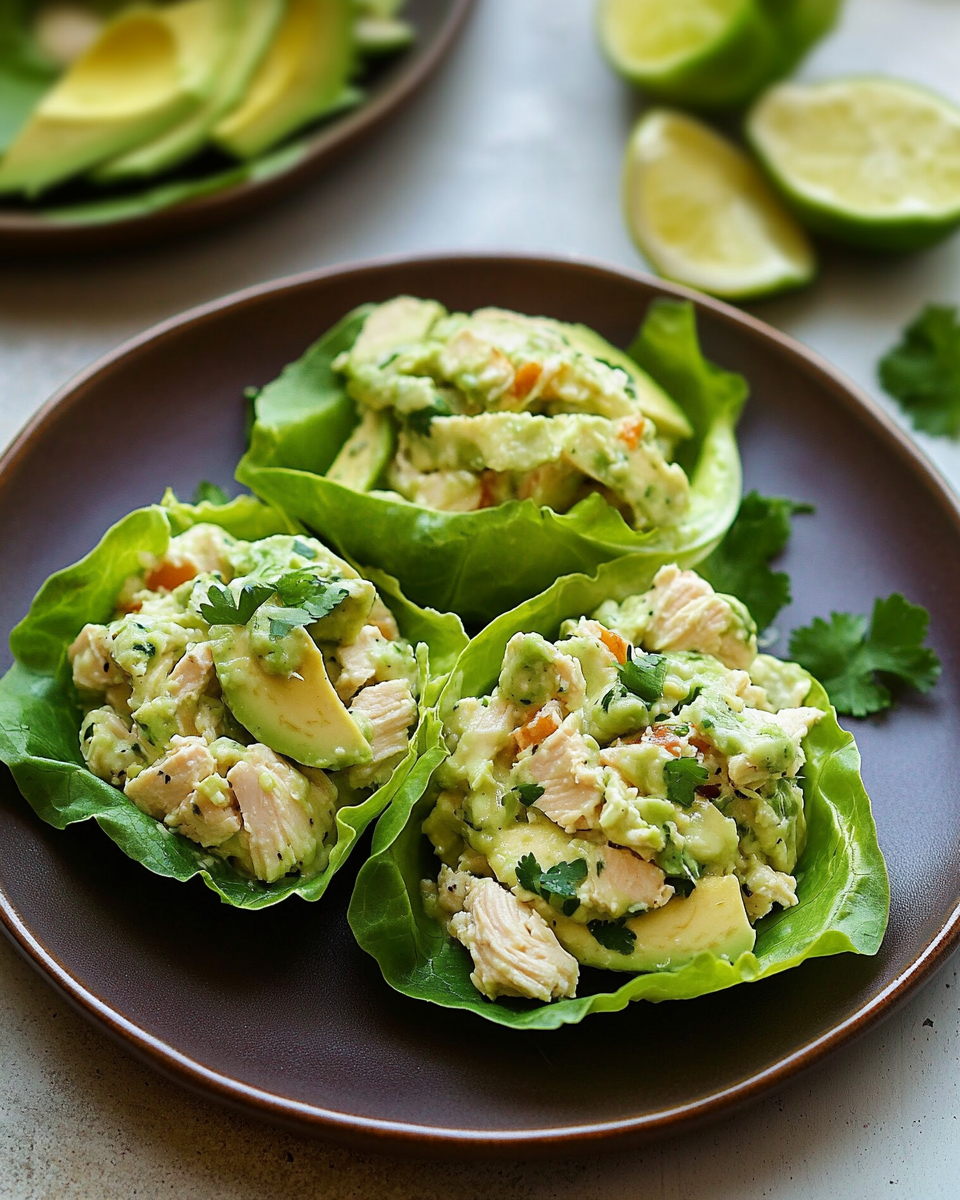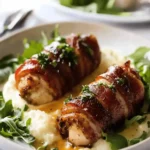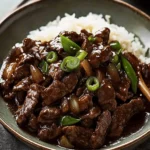This easy sheet pan meal combines tender chicken breasts with colorful vegetables, all coated in a tangy balsamic glaze. It’s a flavorful, healthy dinner option that requires minimal prep and cleanup, perfect for busy weeknights.
FULL RECIPE
Ingredients
- 4 boneless, skinless chicken breasts
- 1 red bell pepper, sliced
- 1 yellow bell pepper, sliced
- 1 zucchini, sliced
- 1 red onion, cut into wedges
- 2 tablespoons olive oil
- 3 tablespoons balsamic vinegar
- 2 tablespoons honey
- 3 cloves garlic, minced
- 1 teaspoon dried Italian seasoning
- Salt and black pepper to taste
- Fresh parsley, chopped (optional, for garnish)
Directions
- Preheat the oven to 425°F (220°C).
- In a small bowl, whisk together balsamic vinegar, honey, olive oil, garlic, Italian seasoning, salt, and pepper.
- Place the chicken breasts on a large sheet pan. Arrange the bell peppers, zucchini, and red onion around the chicken.
- Drizzle the balsamic glaze evenly over the chicken and vegetables. Toss the veggies lightly to coat.
- Bake for 20-25 minutes or until the chicken is cooked through (internal temperature 165°F/74°C) and vegetables are tender.
- Garnish with chopped parsley before serving, if desired.
Nutritional Information
- Calories: 320
- Protein: 35g
- Fat: 10g
- Carbohydrates: 12g
- Fiber: 3g
- Sugar: 9g
- Sodium: 280mg
The History of Balsamic Vinegar and Its Role in Cooking
Balsamic vinegar originates from Italy, specifically the Modena and Reggio Emilia regions. Traditional balsamic vinegar is made by aging grape must in wooden barrels for years, resulting in a rich, sweet, and tangy flavor. Its use in cooking has evolved from a simple condiment to a key ingredient in marinades, dressings, and glazes. In the balsamic glazed chicken and veggie recipe, balsamic vinegar adds depth and complexity, balancing the natural sweetness of honey and the savory notes of garlic and herbs.
The Health Benefits of Using Balsamic Vinegar
Balsamic vinegar is not just flavorful but also offers several health benefits. It contains antioxidants that help protect the body from damage caused by free radicals. The vinegar has been shown to support digestion and improve blood sugar regulation, making it a smart choice for people managing diabetes. Its low calorie and fat content contribute to a healthy diet without sacrificing taste, which aligns perfectly with the wholesome nature of this sheet pan meal.
Choosing the Right Chicken for the Recipe
Selecting the right cut and quality of chicken is essential for the success of this recipe. Boneless, skinless chicken breasts are preferred for their lean protein content and quick cooking time. Choosing organic or free-range chicken can enhance the flavor and nutritional profile. Proper handling and cooking ensure the chicken remains juicy and tender, which is crucial since the vegetables cook alongside and need the same baking time.
The Importance of Vegetable Selection
The vegetables chosen for this dish—bell peppers, zucchini, and red onions—are colorful and nutrient-dense, making the meal visually appealing and balanced in vitamins and minerals. Bell peppers provide vitamin C and antioxidants, zucchini offers hydration and fiber, and red onions add a mild sweetness and anti-inflammatory properties. The mix of textures and flavors enhances the eating experience and complements the balsamic glaze perfectly.
The Role of Olive Oil in the Recipe
Olive oil is used not only as a cooking fat but also as a flavor enhancer in this recipe. Rich in monounsaturated fats and antioxidants, it contributes to heart health and adds a smooth mouthfeel. When combined with balsamic vinegar and honey, olive oil helps create a luscious glaze that coats the chicken and vegetables evenly, aiding caramelization during roasting.
How Honey Enhances the Balsamic Glaze
Honey adds natural sweetness to the glaze, balancing the acidity of the balsamic vinegar. It also aids in caramelizing the chicken and vegetables in the oven, creating a slightly sticky, glossy finish that elevates the dish’s flavor and appearance. Besides taste, honey has antimicrobial properties and offers a quick energy boost through its natural sugars.
Garlic and Its Nutritional and Flavor Contributions
Garlic is a powerful ingredient that provides a pungent, aromatic flavor that complements the balsamic glaze. Beyond flavor, garlic has immune-boosting properties and is known for its cardiovascular benefits. It contains sulfur compounds that have been linked to lowering blood pressure and cholesterol levels, making it a healthy addition to this dish.
Italian Seasoning Blend and Its Effect on Flavor
The dried Italian seasoning mix usually includes herbs like oregano, basil, thyme, and rosemary. These herbs infuse the chicken and vegetables with an earthy, savory profile that balances the sweetness and acidity of the glaze. The seasoning also adds complexity and depth, creating a well-rounded flavor experience typical of Mediterranean cuisine.
The Science Behind Sheet Pan Cooking
Sheet pan cooking is popular for its convenience and ability to cook an entire meal in one pan. The even heat distribution in the oven allows the chicken and vegetables to roast simultaneously, developing caramelization and flavor without excess moisture. This cooking method reduces cleanup time and encourages healthier meals since it requires minimal oil and no frying.
Tips for Achieving Perfectly Cooked Chicken
Cooking chicken evenly can be challenging, but several tips help ensure success. Using uniform-sized chicken breasts and vegetables promotes even cooking. Checking the internal temperature with a meat thermometer to reach 165°F guarantees safety and juiciness. Letting the chicken rest after baking allows juices to redistribute, preventing dryness.
Maximizing Vegetable Texture and Flavor
To keep vegetables tender yet crisp, it is important not to overcrowd the sheet pan, which can cause steaming rather than roasting. Cutting vegetables into similar sizes ensures even cooking. Tossing them in the balsamic glaze before baking allows the flavors to meld while creating slight caramelization on the surface, enhancing taste and texture.
Variations to Customize the Recipe
This recipe is versatile and can be easily modified to suit different tastes or dietary needs. Swapping vegetables such as asparagus, cherry tomatoes, or mushrooms can change flavor profiles and nutritional benefits. Using chicken thighs instead of breasts adds richness. For a vegan option, tofu or tempeh can replace chicken while maintaining protein content.
Meal Prep and Storage Suggestions
This balsamic glazed chicken and veggie dish is ideal for meal prepping. It keeps well in airtight containers in the refrigerator for up to four days. Reheating in the oven or microwave works well, though the vegetables may soften further. Freezing is possible but may slightly alter texture, so fresh preparation is preferable when possible.
Pairing Ideas for a Complete Meal
To round out this dish, consider serving it alongside whole grains like quinoa, brown rice, or couscous, which absorb the flavorful glaze and add fiber. A side salad with fresh greens and a light vinaigrette complements the richness of the balsamic glaze. For a heartier meal, crusty whole-grain bread is a satisfying addition.
Nutritional Balance and Portion Control
This sheet pan meal offers a balanced mix of protein, fiber, healthy fats, and vitamins. Watching portion sizes is important to maintain calorie control, especially with added honey. Pairing the dish with a fiber-rich side or fresh vegetables can increase satiety and promote digestive health, making it suitable for weight management or general wellness goals.
The Environmental Impact of Sheet Pan Meals
Sheet pan cooking is energy-efficient, requiring just one oven preheating and minimal cookware, which reduces water and electricity use. Using seasonal vegetables and responsibly sourced chicken further lessens environmental impact. Meals like this promote sustainability by minimizing waste and encouraging whole food consumption.
Why This Recipe Is Ideal for Busy Lifestyles
The minimal preparation time, one-pan cooking, and simple ingredients make this recipe perfect for those with busy schedules. It requires little hands-on time, freeing up the cook for other activities. Cleanup is also easy since everything cooks on one sheet pan, reducing stress and making home-cooked meals more accessible.
How to Elevate Presentation for Entertaining
Though simple, this dish can be dressed up for guests by garnishing with fresh herbs like parsley or basil and serving on decorative platters. Adding a sprinkle of toasted nuts or crumbled feta cheese provides texture and visual interest. Pairing with a crisp white wine or sparkling water with lemon enhances the dining experience.
Advertisement
Common Mistakes to Avoid When Making This Recipe
Overcrowding the pan can lead to soggy vegetables instead of roasted crispness. Using too much glaze early on can cause burning, so it’s better to reserve some for drizzling after baking. Not checking the chicken’s internal temperature risks undercooking or dryness. Cutting vegetables unevenly results in inconsistent cooking.
Cultural Influence and Popularity of Sheet Pan Dinners
Sheet pan meals have gained popularity worldwide for their convenience and adaptability. They reflect a shift toward simpler cooking techniques that save time without sacrificing flavor. This balsamic glazed chicken and veggie recipe combines Mediterranean flavors with modern ease, illustrating how traditional ingredients can fit into contemporary lifestyles.
Conclusion
Balsamic glazed chicken and veggies on a sheet pan is a wonderfully versatile, flavorful, and nutritious meal that suits a variety of lifestyles and preferences. Its blend of sweet, tangy, and savory flavors highlights the beauty of simple ingredients elevated through smart cooking techniques. Whether for a busy weeknight or a casual gathering, this recipe delivers satisfaction with minimal effort and maximum taste, making it a valuable addition to any home cook’s repertoire.






